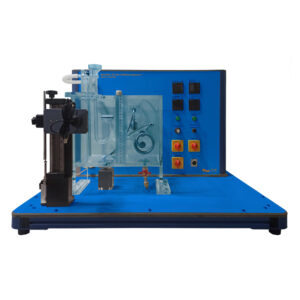Process engineering regularly encounters flow across particle layers. Fixed and fluidized beds in reactors are exposed to through-flowing liquids and gases. Another application is the separation of solids from suspensions using cake and depth filtration.This equipment can be used to explore the fluid mechanics of flow through fluidized and fixed beds. A glass test tank that can be filled for the purpose and through which water can be made to flow from both ends is provided. For bulk solids, a sintered-metal plate acts as the foundation.The test tank receives water from the lab’s water connection. The water enters the test tank from the top in order to study flow through fixed beds. It goes through the sintered-metal plate and fixed bed before going through a distributor and out the outlet.
Quick-release couplings allow for the modification of the experimental setup. This also makes it possible to study fluidized beds and reverse the flow through the test tank. Through the fixed bed and the porous sintered- metal plate, the water rises. The flow simply passes through the fixed bed if the water’s velocity is less than the so-called fluidization velocity. A fluidized bed forms at increasing speeds. Water enters an expansion tank through the test tank’s head. It then enters the outlet from there. Regardless of the setup, a valve controls the flow rate and a flow metre provides an indication of it. Two manometers with different measuring ranges are offered in order to calculate the pressure loss via the fixed bed or fluidized bed. Through valves, the desired manometer can be selected.




